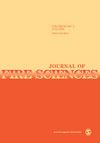Experiments in aerial firefighting with and without additives and its application to suppress wildfires near electrical transmission lines
IF 1.9
4区 工程技术
Q2 ENGINEERING, MULTIDISCIPLINARY
引用次数: 2
Abstract
A comparison scheme is proposed to extinguish non-uniform fire scenes and continuously uniform fire scenes using a helicopter’s bucket fire-extinguishing device to spray extinguishing agent. Pure water, and Class AB, gel, and Class A extinguishing agents were added to the bucket fire-extinguishing device to spray 4-layer, 6-layer, and 12-layer wood crib fires. It was discovered that the depth (the distance from the top of the wood crib) of effective cooling and prevention of temperature recovery by extinguishing agents was 0.36 m and that the cooling performance of the extinguishing agents in sequence from high to low was Class A extinguishing agent > gel extinguishing agent > Class AB extinguishing agent > pure water. Their capacity to prevent temperature recovery in the wood crib fires in sequence from high to low was gel extinguishing agent > Class A extinguishing agent > Class AB extinguishing agent > pure water. A device has been developed that can add extinguishing agent to the helicopter bucket efficiently, and its application on-site during the 2020–2021 Spring Festival and other events showed that it can quickly extinguish small-area wildfires near electrical transmission lines to reduce line trips due to wildfire.有添加剂和无添加剂的空中灭火实验及其在抑制输电线路附近野火中的应用
提出了利用直升机桶式灭火装置喷淋灭火剂扑灭非均匀火场和连续均匀火场的比较方案。在桶式灭火装置中加入纯净水、AB类、凝胶、A类灭火剂,分别喷洒4层、6层、12层木床火灾。发现灭火剂有效冷却和防止温度恢复的深度(距木槽顶部的距离)为0.36 m,灭火剂的冷却性能从高到低依次为A类灭火剂>凝胶灭火剂> AB类灭火剂>纯水。它们在木槽火灾中防止温度恢复的能力从高到低依次为凝胶灭火剂> A类灭火剂> AB类灭火剂>纯水。研制了一种高效向直升机铲斗中添加灭火剂的装置,并在2020-2021年春节等活动的现场应用表明,该装置可以快速扑灭输电线路附近的小区域野火,减少因野火导致的线路跳闸。
本文章由计算机程序翻译,如有差异,请以英文原文为准。
求助全文
约1分钟内获得全文
求助全文
来源期刊

Journal of Fire Sciences
工程技术-材料科学:综合
CiteScore
4.00
自引率
0.00%
发文量
14
审稿时长
2.5 months
期刊介绍:
The Journal of Fire Sciences is a leading journal for the reporting of significant fundamental and applied research that brings understanding of fire chemistry and fire physics to fire safety. Its content is aimed toward the prevention and mitigation of the adverse effects of fires involving combustible materials, as well as development of new tools to better address fire safety needs. The Journal of Fire Sciences covers experimental or theoretical studies of fire initiation and growth, flame retardant chemistry, fire physics relative to material behavior, fire containment, fire threat to people and the environment and fire safety engineering. This journal is a member of the Committee on Publication Ethics (COPE).
 求助内容:
求助内容: 应助结果提醒方式:
应助结果提醒方式:


